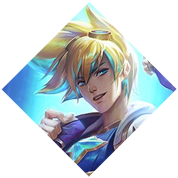Why Blue Side Wins More in League of Legends - Blue Side Advantage
In League of Legends, there’s a long-standing pattern where blue side tends to win more than the red side. Currently, LeagueofGraphs puts blue side at a 51% winrate, over red side's 49%. While this may seem like a small percentage, consider that this is a trend with a humongous sample size. It encompasses every single game going on in the ranked queue, which should flatten all outlying variables like luck or draft.
This imbalance has sparked debate across the community, from casual solo queue players to pro analysts. Riot has tried to fix it by adjusting draft rules, tweaking jungle layouts, and even shifting pick priorities, but the pattern still shows up in data. This trend even shows up in other MOBAs, with DotA 2's Dire side currently sporting an incredible 59% winrate.
The goal of this article is to explain why. We’ll look at map layout, pick/ban structure, vision control, and more. If you’ve ever wondered whether side selection really matters, the short answer is yes, and here’s how.
What’s the Blue Side in League of Legends?
Blue side refers to the team that starts on the bottom left corner of the map. The red side starts top-right. This orientation affects how players experience the game, both visually and strategically.
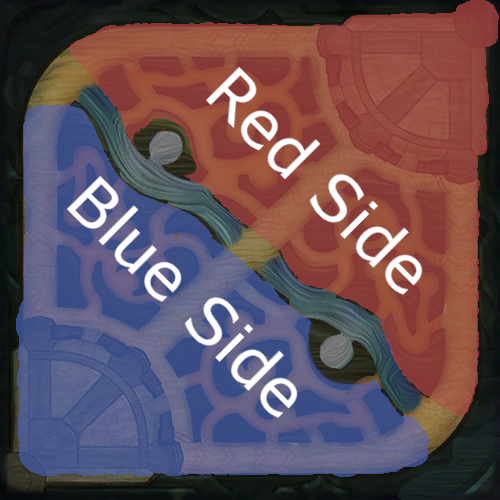
In League of Legends, the default camera naturally scrolls upward and rightward, which aligns with standard screen movement. Aiming skillshots, map awareness, and even pinging can feel smoother. This is subtle, but for high-skill players, it adds up.
Over time, this small detail was ironed out with new camera settings that tilt the camera down and leftward for redside. However, with the bottom of the screen being occupied by your stats, items and abilities, there's a lot of visual real estate that blueside enjoys, that redside does not.
Granted, all these can be bridged by changing settings, but the average player does not change their configuration too much.
Gameplay-wise, both sides have mirrored jungle camps, but the layout creates asymmetries. We’ll cover those shortly. For now, just remember: blue team is always on the bottom-left, and red is top-right. In ranked games, your side is assigned randomly. In pro play, teams often get to choose.
Win Rate Differences – By Patch, Region, and Elo
Across various patches and regions, the blue side consistently maintains a slight advantage in win rates. This edge is evident in both solo queue and professional play, though the exact figures can vary.
Ranked Solo/Duo
In solo queue, the blue side typically holds a win rate advantage ranging from 1% to 2% over the red side. This margin, while seemingly small, is statistically significant given the vast number of games played. Factors contributing to this include better early-game objective control and more favorable camera angles.
Professional Play
In professional leagues, the blue side's advantage is often more pronounced. For professional players, even a slight side advantage is worth exploiting, especially during playoff series where every win counts. For instance, during certain splits, teams on the blue side have achieved win rates exceeding 52%, while red side win rates hovered around 48% . This disparity is influenced by strategic elements like first pick priority during the draft phase and map control dynamics.
Regional Variations
Regional differences also play a role. For example, in the North American (NA) and European (EU) solo queue ladders, the blue side advantage aligns with global trends. However, in regions like Korea, the gap can be slightly wider due to differing playstyles and meta preferences.
Elo Considerations
The blue side advantage tends to be more significant in higher Elo brackets, but it is less pronounced in casual play . At these levels, players are better equipped to capitalize on subtle advantages, such as superior vision control and objective timing. Conversely, in lower Elo tiers, the impact is less pronounced, as games are often decided by individual mechanics and coordination rather than strategic nuances.
In summary, while the blue side isn't overwhelmingly dominant, it consistently offers a measurable edge across various levels of play. Understanding and leveraging this can be crucial for players aiming to optimize their performance.
Objective Control – Dragons, Rift Herald, Baron
Objective control is one of the clearest areas where the blue side benefits. Even though the map is mirrored, the actual geometry and approach angles create a few built-in advantages.
Dragon and Void Grubs Positioning
The map is not symmetrical in how teams can approach objectives, even if they are symmetrically placed. The blue side’s jungle pathing and lane access give it more reliable setups for early and mid-game control.
The team who's next to the wall facing the neutral objective will have an easier time stealing it. The opposite team will have an easier time starting the objective for less risk.
So, while redside has benefits to stealing Void Grubs and Rift Herald, along with safer ways to start dragon, blueside has benefits to the opposite.
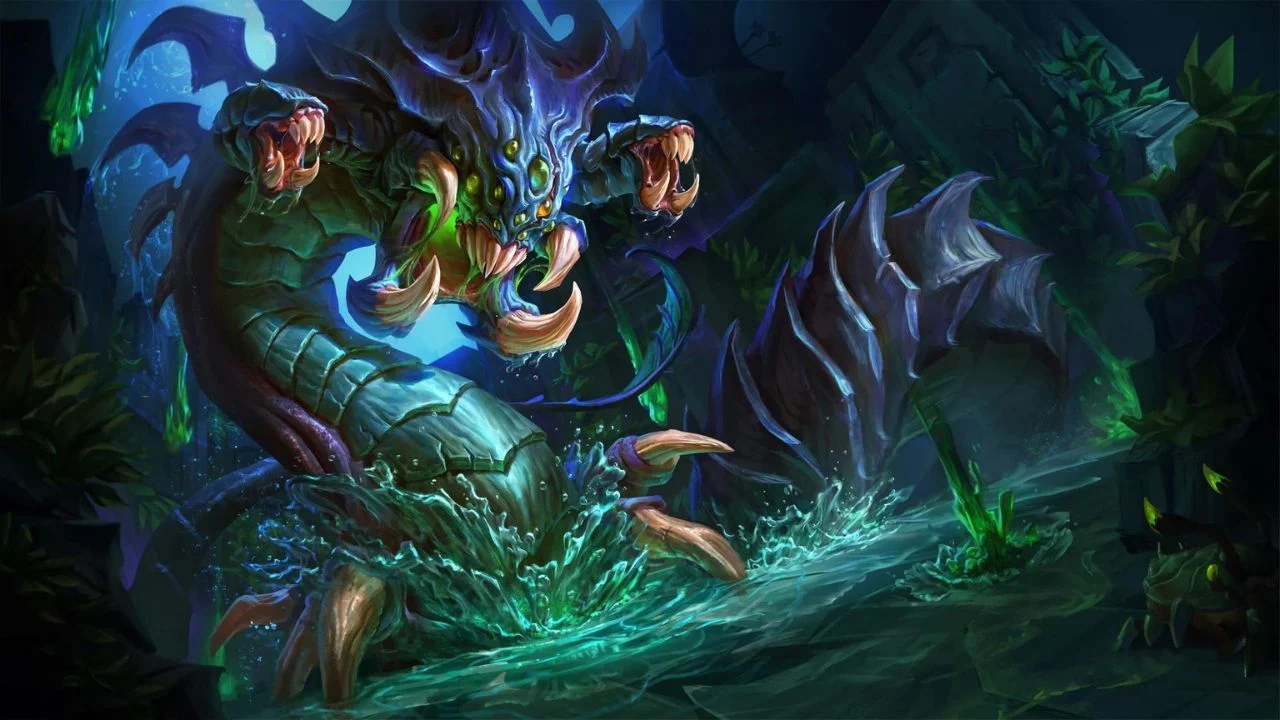
However, a Rift Herald or Void Grub steal is often worthless. Unless the enemy jungler is solo'ing the Herald, it's very possible you won't get the actual buff. Stealing a Void Grub from the enemy team denies progress to Feats of Strength, but it doesn't necessarily help you progress the map.
In the other hand, stealing a dragon is worth it, even if your jungler dies for it. It's permanent progress towards ending the game, that they don't need to pick up like the Herald buff.
As for the benefits to being able to start objectives with less risk, Rift Herald tends to be the slowest and riskiest one to start, outside of Baron Nashor. Blueside being able to start it without as much vision contributes to the higher winrate.
In summary, blueside has better access to dragon steals and starting Herald/Baron. This is simply more valuable than redside's better access to Baron steals.
Which Side Do Professional Teams Choose?
In professional League of Legends, side selection isn’t random. For most tournament formats, the two teams allow the higher-seeded team to pick the side for Game 1, and then it alternates—or the losing team picks in subsequent games. This makes side choice strategic, not incidental.
Blue Side Is Often Picked First
Teams almost always prefer the blue side when given the option, especially in high-stakes matches. This preference is consistent across regions like the LCK, LEC, and LPL. In some splits, blue side pick rates exceeded 65%, even when red side win rates weren’t that far behind.
Why Pro Teams Prefer Blue
1. First Pick Advantage:
Blue side gets first pick in champion select, which lets them secure a top-tier flex or overpowered champion before red side can respond. This can often anchor an entire draft.
2. More Predictable Draft Flow:
Red side gets final pick (counterpick), but that only matters if you know where to apply it. In pro-play, flex picks (champions that can be ambiguously taken to many different lanes) and safe picks are the current meta. This means that, as a pro-player, being last pick is generally not as valuable as being first pick, since counterpicks are less common.
3. Vision and Tempo:
Teams often script early game plays to secure dragons and Herald. As mentioned earlier, these plays are easier to control from blue side due to jungle and lane access.
Exceptions
In certain metas, red side counterpick becomes more valuable, along with easier access to toplane for a level 3 gank. We've seen this happen in games where top and botlane switch for the first few minutes of the game.
Why the Map Design Favors Blue Side
While the map is technically mirrored, it doesn’t play out symmetrically. One side consistently ends up with better access to objectives and vision control. Blue side has a few small, but meaningful, layout advantages that shape how the game can develop. Let's break it down into the most impactful areas.
River Control
The bottom river quadrant is more accessible to the blue side. It curves downward, aligning better with their mid and bot lane entrances. Blue mid laners often have safer routes to ward river or contest vision around dragon. Red side mids have to walk further and expose themselves more to do the same.
Jungle Gank Pathing
Blue side junglers benefit from more fluid early pathing and quicker access to the duo lane:
- Starting red - full clear - bot side scuttle leads naturally into a bot lane gank. While an early botlane gank is often desirable compared to a toplane gank, not all junglers clear as quickly starting red.
- Because of the geometry of blue’s jungle, ganks from behind the bottom lane tower brush are quicker and harder to ward against. Junglers like Amumu and Sejuani can dash through the tri-bush wall on redside jungle to gank, something that redside junglers cannot do in toplane.
- On red side, bottom lane ganks usually require looping wide or committing to riskier angles through tri-brush.
This results in more effective early ganks for the blueside jungler, especially when combined with bot lane priority. While most redside junglers enjoy the same benefits when ganking toplane, this is a far less valuable gank for progressing the game.
Camera Angle and the Invisible Edge
There’s a built-in visual bias in League of Legends, and it favors the blue side.
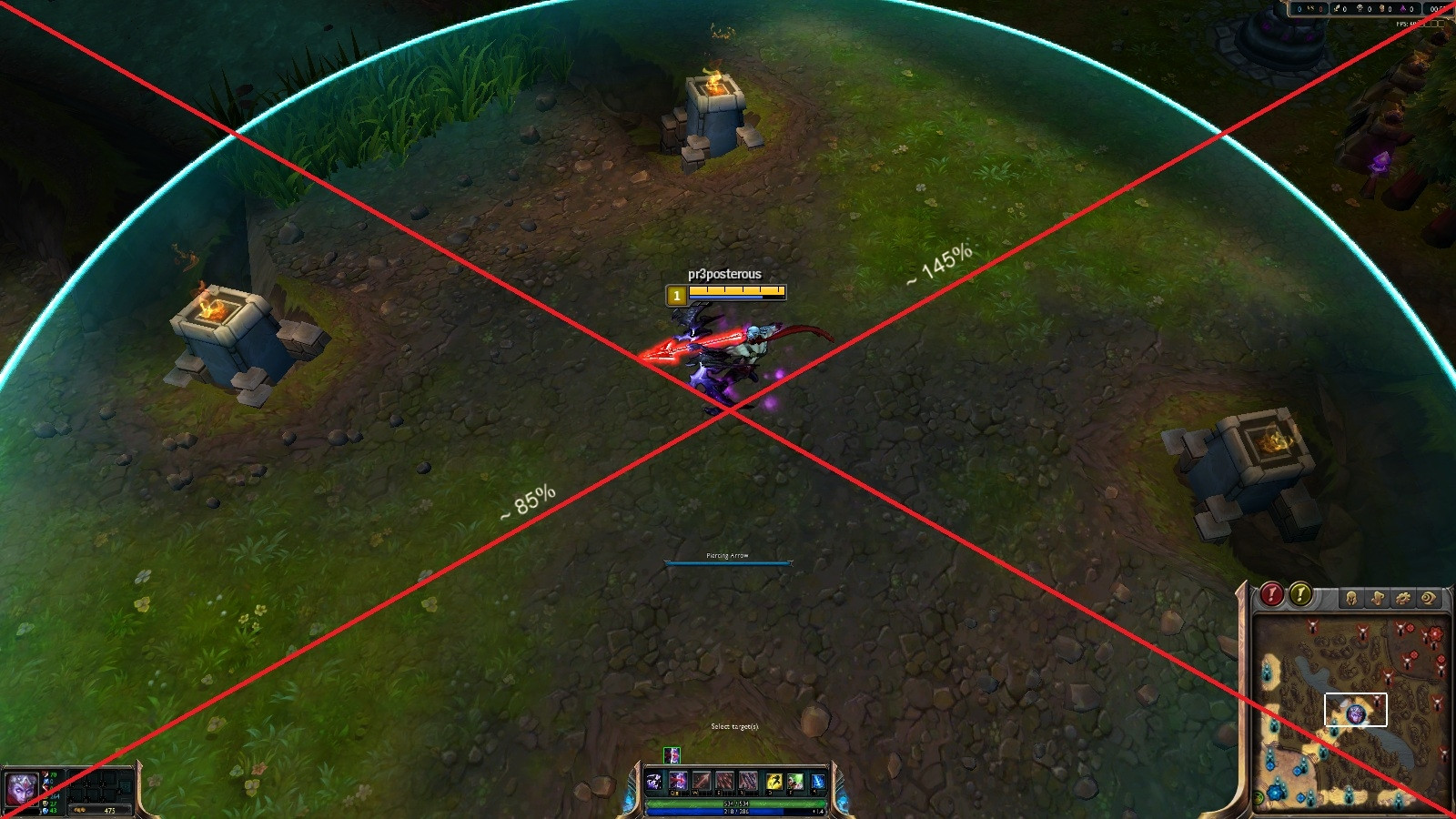
The default in-game camera is angled slightly from above and to the southwest. That means players on the blue side look up and to the right, while red side players look down and to the left. This isn't just cosmetic—it affects what you can see and react to. These visual quirks create subtle blind spots for red side players, especially when fighting near walls or choke points.
What This Means for Gameplay
- Skillshots from red side often feel harder to land. You’re aiming against the perspective, which compresses vertical space. This is extremely noticeable when factoring in small differences in the map geometry's height. If you've tried to hit skillshots on somebody who's in the river while not being in it yourself, you've probably already noticed this.
- Ward placement and fog of war behave differently. It’s easier for blue players to see enemies coming from red jungle corridors than the reverse.
- In teamfights, spell effects and animations can visually obscure red side’s view more than blue’s, while blue players often have a better view during chaotic teamfights, especially in crowded objective fights.
Why Doesn’t Riot Games Fix It?
Camera mirroring isn’t a simple toggle. It would affect gameplay on multiple fronts, from ability targeting to macro shot-calling. It affects UI, ability targeting, and countless baked-in assumptions about how players move. Riot has said it’s on their radar, but no full fix has been implemented in standard modes yet.
Riot’s Attempts to Balance Side Advantage
Over the course of multiple seasons, Riot Games hasn’t ignored the blue side advantage. Over the years, they’ve made several changes aimed at leveling the field. Some had noticeable impact, others barely moved the needle.
Draft Phase Adjustments
The most visible tweak was to champion select rules:
- Blue side gets first pick, red side gets last pick (counterpick).
- Red side also gets to counter two roles in the second ban phase, giving it a better chance to disrupt blue’s early picks.
- Riot has experimented with ban orders and timing to create more balance, especially in pro play where draft edges are magnified.
These changes help a bit, but teams still overwhelmingly prefer blue side in Game 1s and blind matches, which suggests they’re not enough.
Jungle and Objective Shifts
Riot has also changed:
- Jungle spawn timers
- Scuttle crab locations
- Rift Herald and Dragon respawn timings
- Wall placements and brush layouts
Some patches made objectives harder to control from blue, others smoothed out red’s jungle clear speeds. But again, these were small adjustments. The core map structure remained untouched.
Map Geometry
There have been no major reworks to Summoner’s Rift’s base geometry since the 2014–2015 update, markedly the 2024 update that added new symmetrical walls to the Rift. This means most of the core vision, pathing, and approach angle asymmetries remain baked in.
Can the Camera Be Fixed Like in DotA?
Some players have pointed to other games, like Battlerite or Dota 2,as examples of how to mirror the camera for fairness. In those games, both teams view the map from the same relative angle, even though they start on opposite sides. Objectives are symmetrically placed in the middle of river, even though they start on opposite sides of the map for the two sides and tend to rotate around the map, rather than stay in one position.
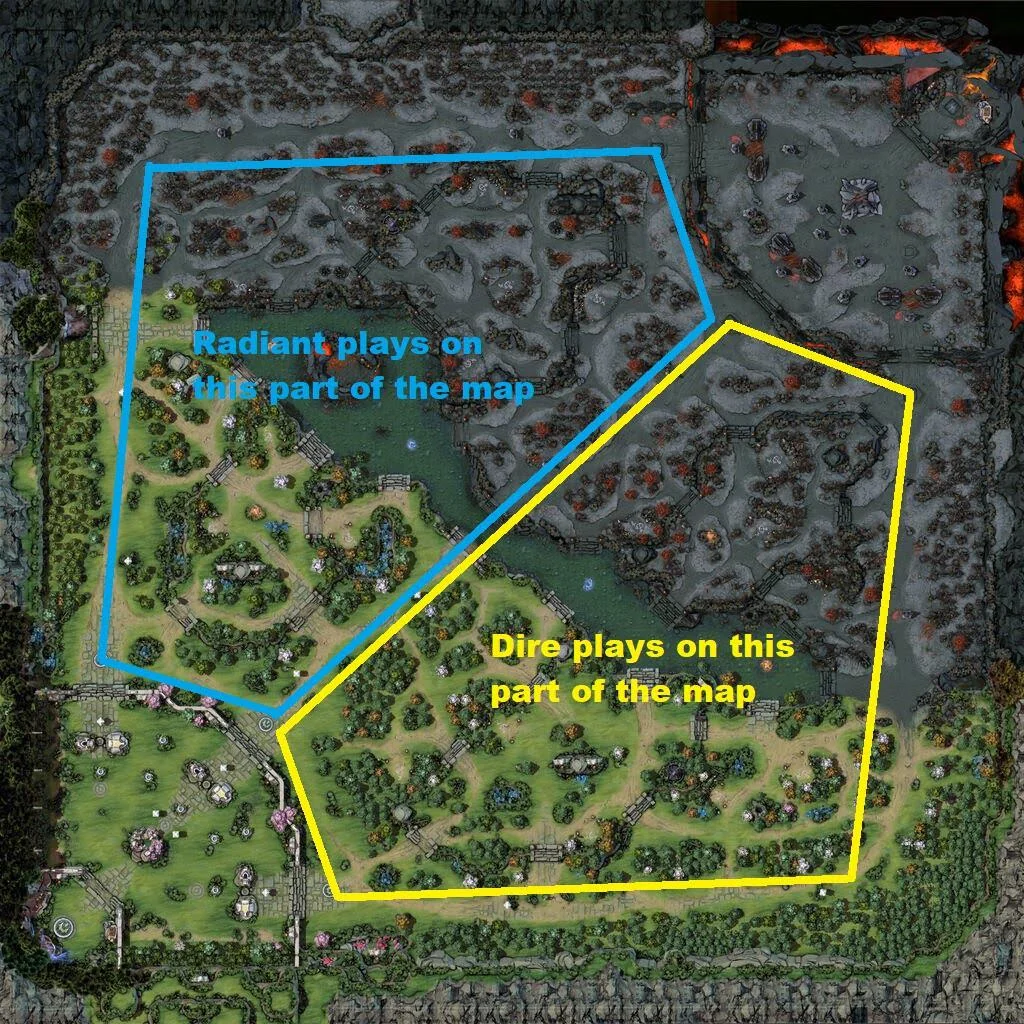
This approach makes sure that skillshots, warding, and vision control feel consistent no matter which side you're on. However, the map geometry itself is built around this fact.
Due to how the jungle is mapped and laid out, Radiant’s botlane will always be their safe lane, and Dire’s botlane will also always be their safe lane. While this makes the lanes asymmetrical if you look at the river, this ends up creating an axis of symmetry around midlane, rather then the river.
This change may seem small, but it can play a huge role when your side of the axis is better suited for some objectives which may progress the game better or worse than the enemy team’s objectives.
What About League?
League of Legends is relatively unique when it comes to desktop MOBAs in this quirk.
Riot has tested camera mirroring before, but the entire map's visual design is made with this lack of mirroring in mind. The Summoner's Rift would need to be entirely remade, both in visuals and map geometry, to account for being able to see the map from the other side.
When the game first came out, this was seen as too much of a sink in resources. And so, we got the layout we are used to today.
It's unlikely we'll see this change in the future, but changes over time could address the difference. It is largely, not a huge difference, but it is one that is exacerbated in pro-play.
Frequently Asked Questions About Blue Side vs Red Side
Why Does Blue Side Win More in LoL?
Blue side has better early jungle paths, dragon access, and camera visibility, giving it a small edge.
Is Blue Side Always Better in League?
Not always, but it's mildly statistically favored. The advantage is small but consistent, and is only a noticeable factor in pro-play.
How Do Pro Teams Choose Which Side to Play?
Higher-seeded teams pick first; most choose blue for first-pick draft and map control benefits.
Which Champions Perform Better on Blue Side?
Rumble, Qiyana, Amumu and Heimerdinger have an average boost of 5-7% in their winrate when played blueside, due to the worse pathing towards top for junglers.
What’s the Blue vs Red Side Win Rate in Ranked vs Pro Play?
In ranked, blue wins about 51–52% of games. In pro play, the gap can stretch slightly wider.
Has Riot Done Anything to Fix the Blue Side Advantage?
Yes, changes to draft order, jungle layout, and pick/ban rules, but the advantage still remains.
Does Pick and Ban Phase Favor Red or Blue Side?
Blue side gets first pick; red side gets last pick. First pick tends to matter more in most metas.
Why Does the Camera Angle Give Blue Side an Edge?
The camera favors upward view from blue side, making skillshots and warding slightly easier to manage, especially when considering potential ganks.





